November 2025
The global industrial enzymes market size reached USD 8.19 billion in 2024 and is projected to hit around USD 16.04 billion by 2034, expanding at a CAGR of 6.95% during the forecast period from 2025 to 2034. Rising need from various industries, including food and beverages, biofuel, and pharmaceuticals, demands industrial enzymes to enhance product quality and shelf life, boost the market.
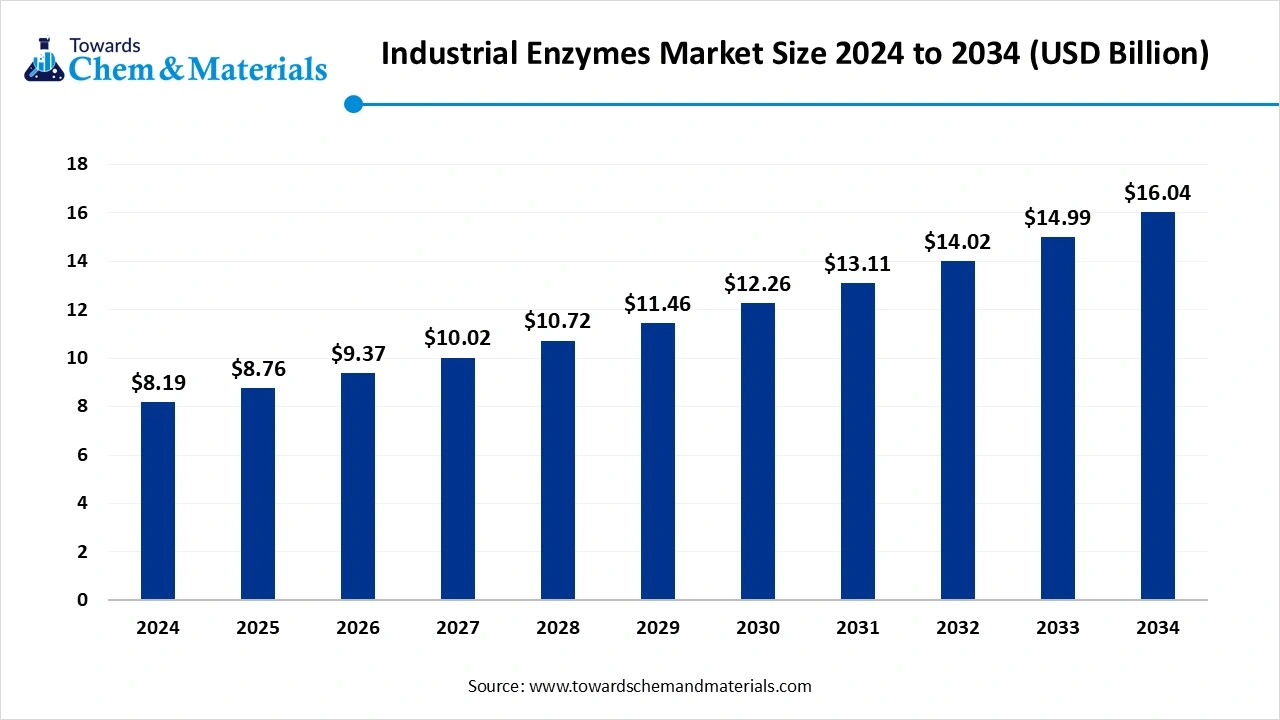
Key Takeaways
Increasing Demand For Sustainable And Efficient Processes In Various Industries And Advancement In Biotechnology, Accelerate Market Expansion of Industrial Enzymes
Industrial enzymes are proteins used in various commercial processes to catalyze specific reactions. They are used in various manufacturing processes to accelerate chemical reactions and improve efficiency. They are produced by microorganisms, such as bacteria, yeasts, and fungi, and are utilized in industries like food and beverage, detergents, and biofuel.
Advancement in biotechnology allows for the modification of enzymes via protein engineering and directed evolution, leads to the creation of enzymes with enhanced stability and efficiency. Enzymes possess numerous advantages over traditional chemical processes, making them ideal for a variety of industrial applications. New applications for industrial enzymes including the production of high-value chemicals and materials, and the utilization of waste biomass, may drive the industrial enzymes market in future.
| Report Attributes | Details |
| Market Size in 2025 | USD 8.76 Billion |
| Expected Market Size by 2034 | USD 16.04 Billion |
| Growth Rate from 2025 to 2034 | CAGR 6.95% |
| Base Year of Estimation | 2024 |
| Forecast Period | 2025-2034 |
| Dominant Region | North America |
| Segment Covered | By Product, By Source, By Application |
| Key Companies Profiled | Chr. Hansen Holding A/S, Lesaffre, Adisseo, BASF SE, Novozymes, DuPont Danisco, DSM, NOVUS INTERNATIONAL, Associated British Foods Plc,BioProcess Algae, LLC, Koninklijke DSM N.V |
Enzyme facilitates faster and more complete conversion of biomass into biofuel which reduces need of the harsh chemicals and reduces overall production costs. This enzyme based processes generally requires less energy as compared to the traditional chemical-based processes, making them more environmentally friendly and cost-effective. It can be used in wide range of feedstock including crops, agriculture residue, and even waste materials, makes the biofuel production more sustainable and efficient. The researcher are continuously improving the technology in gene editing and immobilization techniques to enhance their catalytic performance and stability
Enzyme can replace harsh chemicals in various processes, significantly reduces chemical waste and pollution. They are biodegradable and can be easily broken down into harmless components, minimizing long-term environmental damage. Various advancement including biomanufacturing which develops sustainable manufacturing processes. Advancement in synthetic biology is enabling the development of engineered enzymes with enhanced properties and broader applications, shows future opportunities for industrial enzymes market.
Strict regulation limits the industrial enzyme usage due to safety concern, environmental impact, and rigorous testing and approval. Many countries have their specific regulation for enzyme usage. For food enzymes toxicological studies including in vitro and in vivo genotoxicity and systemic toxicity, are often required. Enzyme used in animal feed may require the acute toxicity and dermal sensitization studies, limits the market of industrial enzyme.
North America dominated industrial enzymes market in 2024. The North America industrial enzymes market size was valued at USD 3.17 billion in 2024 and is expected to be worth around USD 6.21 billion by 2034, growing at a compound annual growth rate (CAGR) of 6.96% over the forecast period 2025 to 2034. Strong biotechnology sector, robust research and development, and wide range of industries that depend on enzymes contribute to market growth of industrial enzymes across this region. The region has well established food and beverages industry which widely use enzymes in various applications including food processing and baking. Strong pharmaceutical demands enzymes in drug manufacturing and research, driving the market of industrial enzyme. North America, specifically the United State, has strong biotechnology sector, with advanced infrastructure and presence of enzyme manufacturer, enhancing the innovation and production.
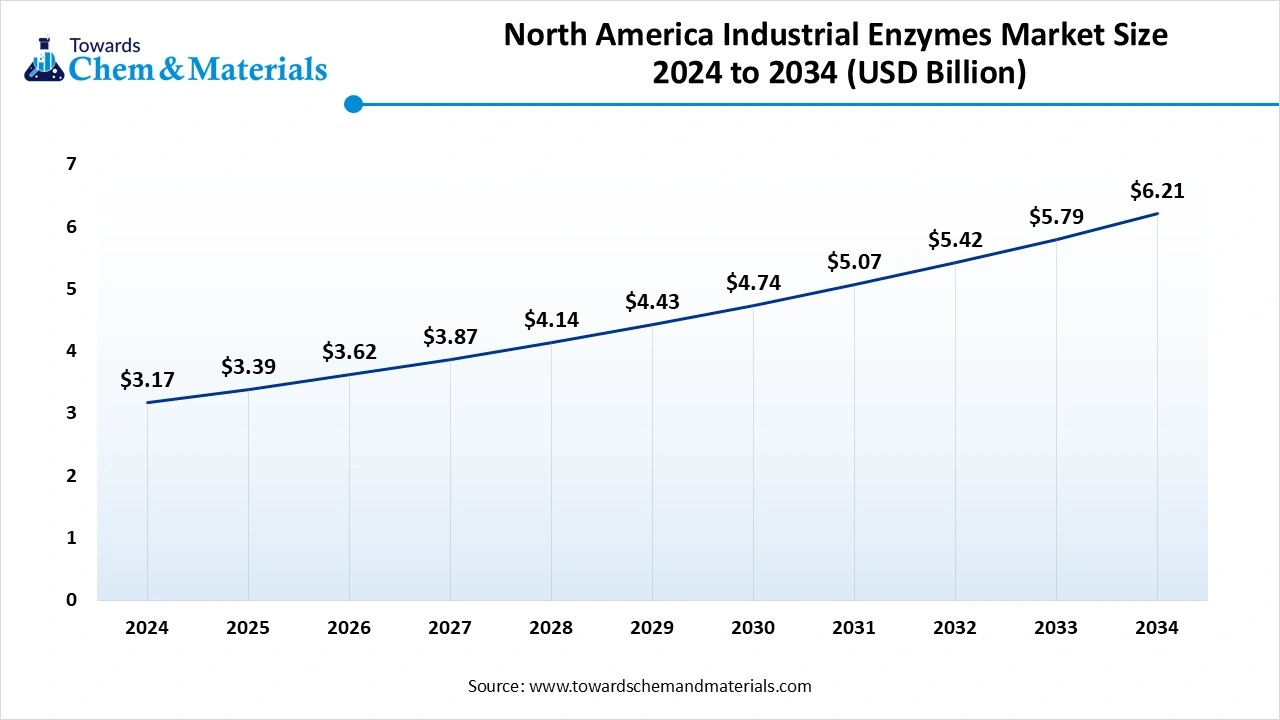
The region invests heavily in R&D activities, leading to the development of new and improved enzymes with enhanced efficiency and performance. Supportive regulatory framework establiblished by US Food and Drug Administration (FDA), ensures the transparency of enzyme based products which develops trust and adoption across various industries. The United States is the largest market for industrial enzymes in North America due to well-established industries and strong biotechnology sector, contribute to regional dominance. Regulations that promote clean and sustainable technologies with the government initiatives to encourage research and development further drive the industrial enzymes market across this region.
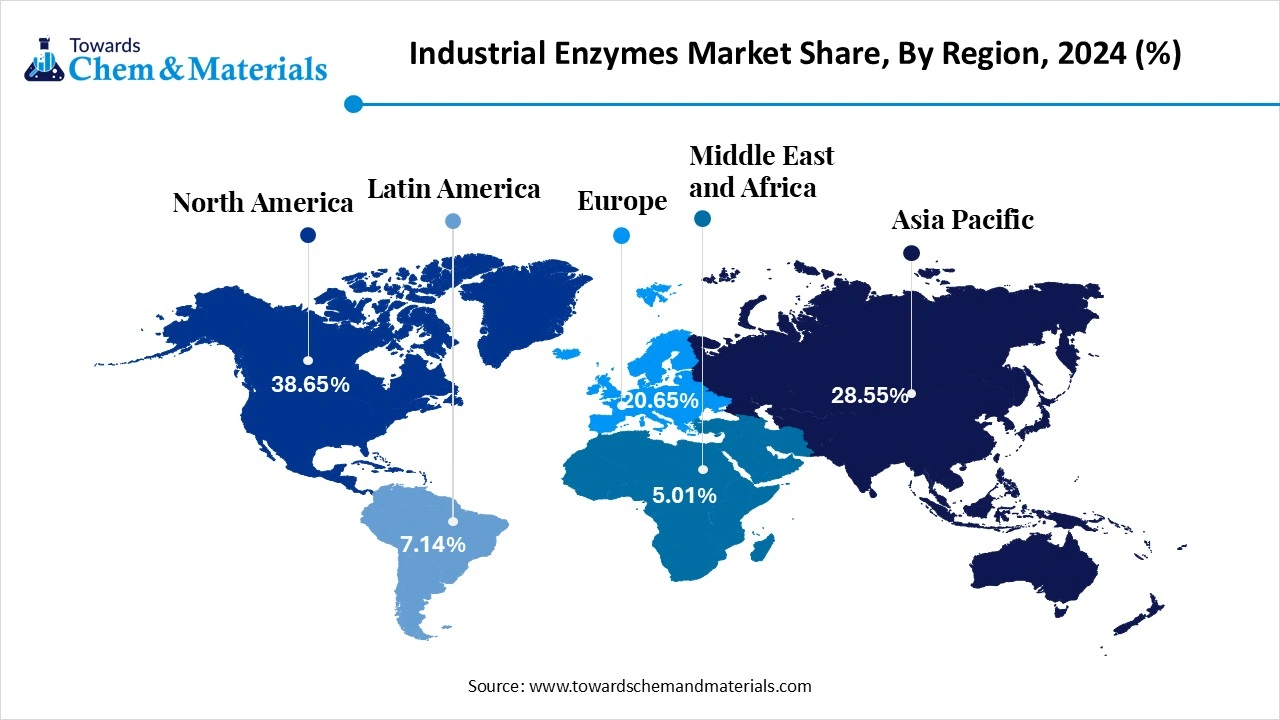
Asia Pacific expects significant growth in industrial enzymes market during the forecast period. Strong growth in food and beverages, healthcare, and chemical industries contribute to market growth of industrial enzyme across this region. Rising disposable income are fueling consumption of processed foods and beverages, further increasing the demand for enzymes. The increasing use of enzymes in bioethanol production, drive the market. Due to extensive food industry and growing pharmaceutical sector china is dominating the market across this region. Consumers are increasingly demands for processed foods and beverages, increases uses of industrial enzymes. Additionally sustainable farming practices and the use of agricultural enzymes to enhance soil fertility and plant growth are also contributing to the region's dominance.
The carbohydrate segments held the dominating share of industrial enzymes market in 2024. Increasing demand in food processing, animal feed, and biofuel production contribute to market growth of this segment. Carbohydrates enhance the quality of products like bread, beer, and dairy which improves texture, flavor and shelf life, boost the market. It also improves the digestibility and nutrient absorption so used in animal feed which improve the performance and productivity of animals. It is used in biofuel production due to its ability to convert the biomass into fermentable sugars. Additionally, carbohydrates are very cost effective because they can be produced on a large scale using microbial fermentation processes, further contribute to carbohydrate segment growth.
The protease segment observed was to grow at a significant rate in the industrial enzymes market during the forecast period. Wide range of applications and versatility in breaking down protein contribute to market growth of the protease segment. Proteases play a very important role in hydrolyzing proteins, which is a fundamental process in many industrial applications. This process is vital for breaking down proteins in animal feed. With increasing global consumption of protein due to rising awareness of its nutritional benefits, is boosting the demand for proteases, especially in the food and beverage industry. Due to their cost effectiveness and efficient production process microbial derived protease are gaining popularity. Protease is used in leather industry to replace traditional chemicals, I food processing to improve nutritional value, further drive the market.
The food and beverage segment held the dominating share of industrial enzymes market in 2024. Widespread use of enzyme in various food processing and beverage application contributes to market growth of this segment. Industrial enzymes are widely used in bakery, dairy, meat processing, and beverages to improve the quality, shelf life and production efficiency. The demand for processed food and functional food is continually increasing, driving the market of enzymes. Innovation developed by food industries including the new product formulation by using enzymes, further boosting demand for industrial enzymes. Rising demand for healthier, sustainable foods, growing popularity of plant-based products, and the increasing use of enzymes in food processing, drive the growth of the food and beverage segment.
The animal feed segment observed to grow at a significant rate in the industrial enzymes market during the forecast period. Increasing demand for animal protein and the role of enzyme in improving livestock health and feed efficacy contribute to market growth of this segment. As the global population increases, demands for meat egg, and dairy products. This increased demand for animal protein significantly increases need for efficient and cost effective feed formulas. Enzymes are added to animals feed to improve the digestibility of nutrients, which allows better nutrient absorption, significantly enhances overall productivity. Various government regulation and growing awerness of environmental sustainability increasing the demand for feed enzymes. Increasing demand for animal protein and growing awareness of benefits of feed enzyme, may contribute to market growth in future.
The microorganisms segment held the dominating share of industrial enzymes market in 2024 due to its cost effectiveness, efficiency and ability to produce wide range of enzymes under controlled conditions. Microorganism are inexpensive to cultivate, produces enzymes. Enzymes derived from microorganisms are used in various industries, including food and beverage, pharmaceuticals, detergents, and textiles. It can be genetically modified to enhance enzyme production and tailor them to specific industrial needs. Growing demand for sustainable manufacturing practice further demand microbial enzymes which is biodegradable and renewable, further boost the market.
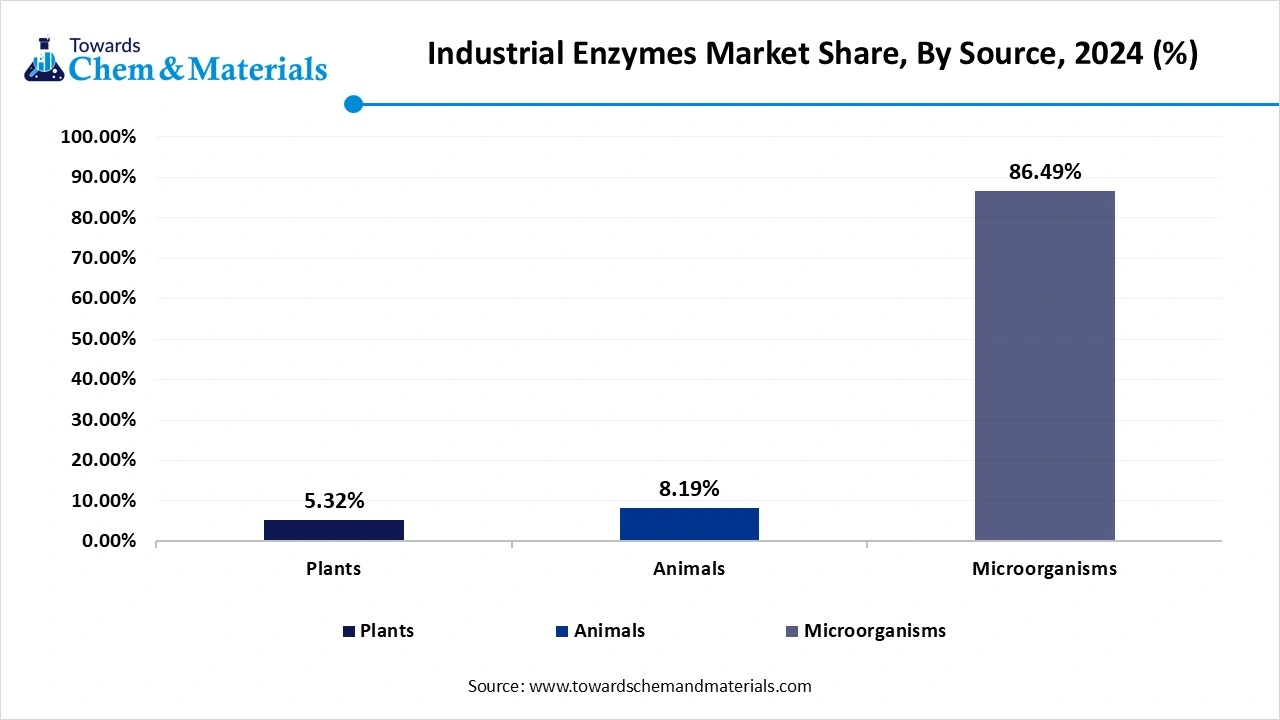
The plant-based enzymes segment observed to grow at a significant rate during the forecast period. They are readily available from various sources including fruits, grains, and vegetables. The extraction method of plant based enzymes is also very simpler and cost effective, makes them ideal choice in industrial applications. They are used widely in food and beverages industry in baking, juice clarification, and dairy production. The growing demand for plant based alternative to the dairy and meat has increased use of plant based enzymes in improving overall functionability in these foods. Shifting consumer preferences for natural, sustainable, and ethical food products, further boost the market of plant based enzymes.
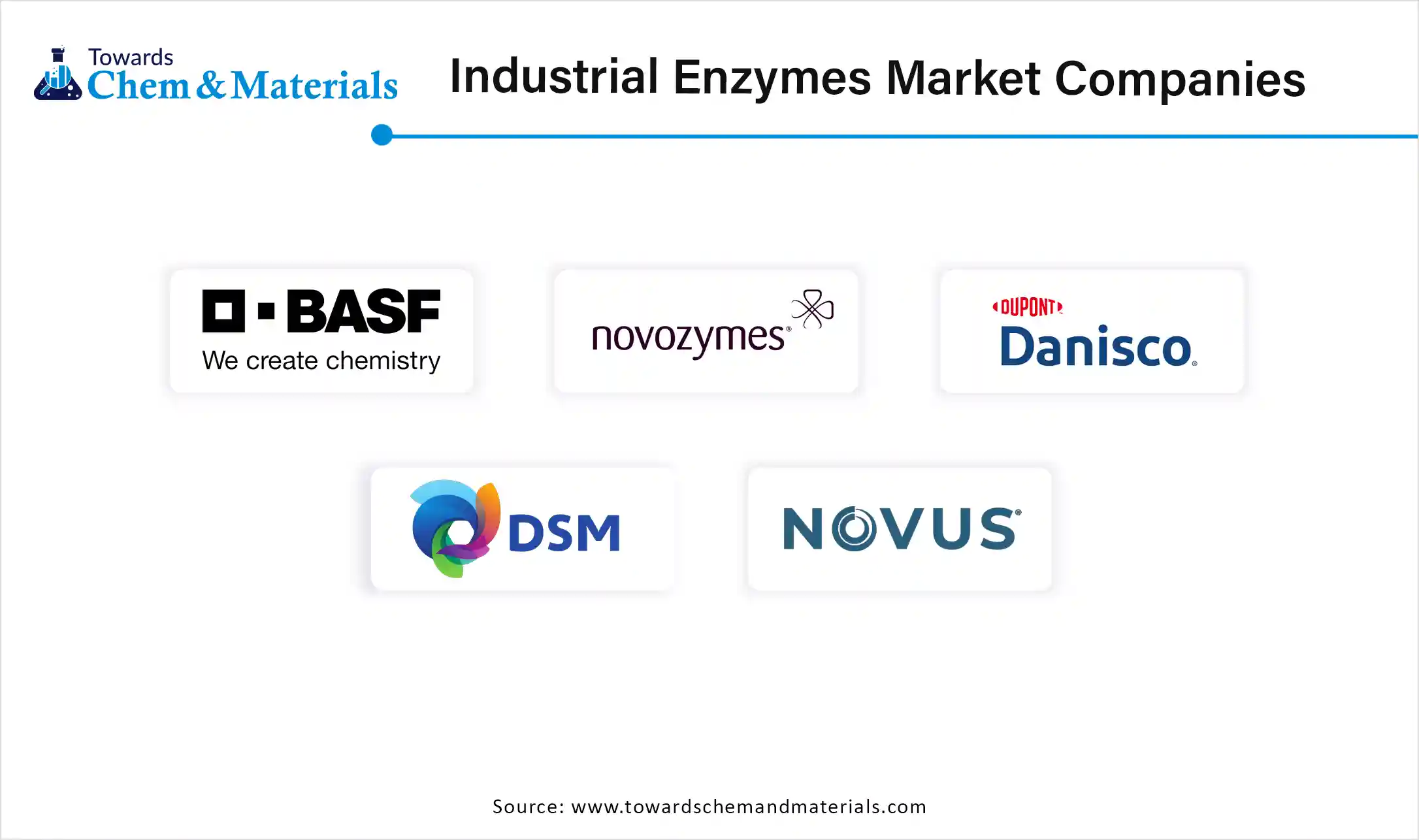
By Product
By Source
By Application
By Region
The Asia pacific renewable diesel market size is calculated at USD 3.16 billion in 2025 and is expected to be worth around USD 8.08 billion by 2034, g...
According to the new research report, the Asia-Pacific heat treating market size was valued at USD 44.59 billion in 2024, grew to USD 46.48 billion in...
The global sludge treatment chemicals market size was USD 7.85 billion in 2024 and is projected to grow from USD 8.30 billion in 2025 to USD 13.65 bil...
November 2025
November 2025
November 2025
November 2025